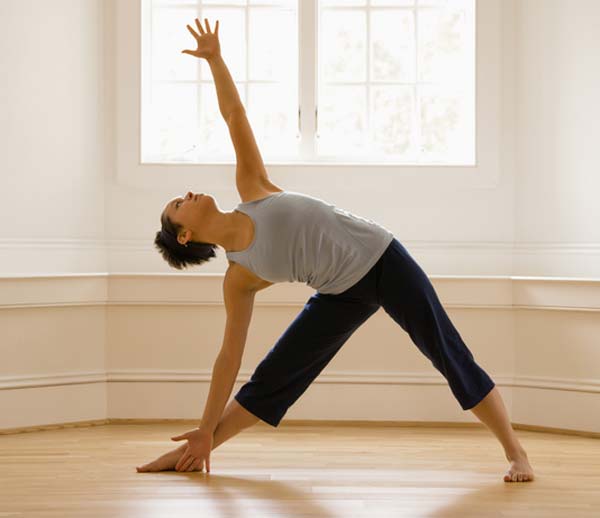Yoga Made Safer: Experts Provide Do's and Don'ts

Many preach that yoga helps keep them centered, toned and flexible. The messages seem to be spreading — according to a recent New York Times article, the number of Americans practicing yoga grew from about 4 million in 2001 to an estimated 20 million in 2011.
But recent news articles have also drawn attention to possible injuries that can come with practicing yoga, such as damage to hip joints, nerves, knees and back.
Here are four tips to remain safe during yoga practice.
Beware of bends
Forward bends, such as Uttanasana, which involves a person standing with their feet together and bending at the hip, can relieve stress and stretch the calves, hamstrings and hips. But certain people should steer clear.
Those with osteoporosis could fracture their spines by bending forward, and those with herniated disks may suffer pain from these stretches, said Dr. Loren Fishman, a New York City physician who is also a yoga instructor.
Fishman said those with herniated disks could do back bends instead. "It's a known physical therapy technique," he said.
Get the world’s most fascinating discoveries delivered straight to your inbox.
However, people with spinal stenosis — narrowing of the spinal column that causes pressure on the spinal cord — should not do back bends, because it may exacerbate their condition, he said.
Fishman also added that 5 percent of people experience the opposite effects of these poses: A small number of people with spinal stenosis benefit from back bends, and a small number of people with herniated disks benefit from forward bends. "It's always best to do test these poses and see what is helping or hurting," Fishman said. "Don't just pick up a rule and run with it."
Individualize your inversions
"The advantages of any inverted pose are terrific," Fishman said. Being upside down can "strengthen the diaphragm, helping people with asthma, emphysema and bronchitis, and bring blood to the upper lung fields, places that are under-infused with blood."
The headstand, known as Shirshasana, can lower blood pressure, temporarily slowing down the heart and calming the body. "It also gives you a different viewpoint on life, which is an added benefit," Fishman said.
But people who have neck or back problems, glaucoma or cerebrovascular problems should not do headstands, Fishman said.
Some people with glaucoma may benefit instead by doing poses such as the Sarvangasana, which is a shoulder stand. Studies examining how headstands and shoulder stands affect the pressure within the eyes have found that it does not increase during shoulder stands, whereas the pressure can double in less than 30 seconds during a headstand, Fishman said.
However, people with neck problems, herniated disks or bad arthritis should not do shoulder stands, Fishman said.
Fishman suggested a safer way for anyone to do another inversion, called the plow, or Halasana, which involves laying on your back and bringing the legs up and over the head until your feet touch the floor. The best way to do this stretch, he said, is to place two blankets under the shoulders for cushioning. Still, it should not be done by people with herniated disks or instability in the neck or upper back, he said.
There has been controversy in the yoga world about whether inversions should be done by menstruating women, Fishman said. Some believe that inverted poses may alter menstrual flow, leading to endometriosis, a condition in which uterine cells grow outside the uterus, in other regions of the abdominal cavity.
Fishman said he has observed menstruating women do headstands and that his advice is "if it hurts, don't do it." But there have been no documented cases of endometriosis resulting from headstands, he said.
Tune-up your twists
Twists, such as Matsyendrasana, a seated, half twist, can stretch the back and hips, massage the abdominal organs and increase blood flow to the spine. But they should not be done by people who have had hip replacement operations, according to Fishman.
"If someone twists to the side of their hip replacement, the prosthetic can be pulled right out," Fishman said. Also, people with herniated disks should make sure to twist away from the side of the disk, he said.
Fishman, in an effort to study yoga's impact on people with osteoporosis, developed a yoga DVD that has been distributed for free around the world. He said despite the fact that many people believe osteoporosis sufferers should not do twists, he has found that twists are not harmful. "We have 49,000 documented hours of people with osteoporosis using our DVD, and no one has ever had a fracture," he said.
Take heed of hot yoga
Yoga done in hot rooms, also known as Bikram yoga, has been touted for its ability to burn fat. However, people with multiple sclerosis (MS) should not participate in this type of yoga, according to Fishman, because heat can worsen the condition's symptoms.
Fishman recommends that those with MS do Iyengar yoga instead, as it focuses on alignment and is gentler on the body.
Pass it on: People with certain conditions should avoid some yoga poses.
This story was provided by MyHealthNewsDaily, a sister site to LiveScience. Follow MyHealthNewsDaily on Twitter @MyHealth_MHND. Find us on Facebook.


